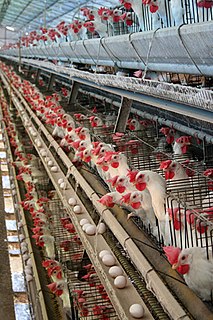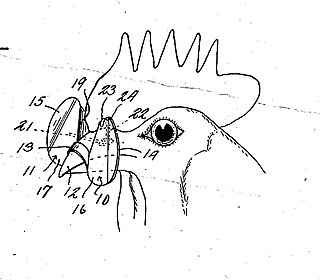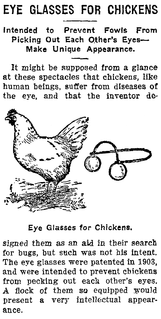 W
WPoultry farming is the form of animal husbandry which raises domesticated birds such as chickens, ducks, turkeys and geese to produce meat or eggs for food. It has originated from the agricultural era. Poultry – mostly chickens – are farmed in great numbers. More than 60 billion chickens are killed for consumption annually. Chickens raised for eggs are known as layers, while chickens raised for meat are called broilers.
 W
WBird food or bird seed is food eaten by birds. While most bird food is fed to commercial fowl, people also use bird food to feed their pet birds or wild birds.
 W
WBlinders, also known as peepers, are devices fitted to, or through, the beaks of poultry to block their forward vision and assist in the control of feather pecking, cannibalism and sometimes egg-eating. A patent for the devices was filed as early as 1935. They are used primarily for game birds, pheasant and quail, but also for turkeys and laying hens. Blinders are opaque and prevent forward vision, unlike similar devices called spectacles which have transparent lenses. Blinders work by reducing the accuracy of pecking at the feathers or body of another bird, rather than spectacles which have coloured lenses and allow the bird to see forwards but alter the perceived colour, particularly of blood. Blinders are held in position with a circlip arrangement or lugs into the nares of the bird, or a pin which pierces through the nasal septum. They can be made of metal (aluminium), neoprene or plastic, and are often brightly coloured making it easy to identify birds which have lost the device. Some versions have a hole in the centre of each of the blinders, thereby allowing restricted forward vision.
 W
WA broiler is any chicken that is bred and raised specifically for meat production. Most commercial broilers reach slaughter weight between four and seven weeks of age, although slower growing breeds reach slaughter weight at approximately 14 weeks of age. Typical broilers have white feathers and yellowish skin. Broiler or sometimes broiler-fryer is also used sometimes to refer specifically to younger chickens under 4.5 pounds, as compared with the larger roasters.
 W
WThe broiler industry is the process by which broiler chickens are reared and prepared for meat consumption. Worldwide, in 2005 production was 71,851,000 tonnes. From 1985 to 2005, the broiler industry grew by 158%.
 W
WCandling is a method used in embryology to study the growth and development of an embryo inside an egg. The method uses a bright light source behind the egg to show details through the shell, and is so called because the original sources of light used were candles.
 W
WCannibalism in poultry is the act of one individual of a poultry species consuming all or part of another individual of the same species as food. It commonly occurs in flocks of domestic hens reared for egg production, although it can also occur in domestic turkeys, pheasants and other poultry species. Poultry create a social order of dominance known as pecking order. When pressure occurs within the flock, pecking can increase in aggression and escalate to cannibalism. Cannibalism can occur as a consequence of feather pecking which has caused denuded areas and bleeding on a bird's skin. Cannibalism can cause large mortality rates within the flock and large decreases in production due to the stress it causes. Vent pecking, sometimes called 'cloacal cannibalism', is considered to be a separate form of cannibalistic pecking as this occurs in well-feathered birds and only the cloaca is targeted. There are several causes that can lead to cannibalism such as: light and overheating, crowd size, nutrition, injury/death, genetics and learned behaviour. Research has been conducted to attempt to understand why poultry engage in this behaviour, as it is not totally understood. There are known methods of control to reduce cannibalism such as crowd size control, beak trimming, light manipulation, perches, selective genetics and eyewear.
 W
WA capon is a cockerel (rooster) that has been castrated or neutered, either physically or chemically, to improve the quality of its flesh for food, and, in some countries like Spain, fattened by forced feeding.
 W
WChick culling or unwanted chick killing is the process of separating and disposing of unwanted chicks, for which the intensive animal farming industry has no use. It occurs in all industrialised egg production whether free range, organic, or battery cage. Worldwide, around 7 billion male chicks are culled per year in the egg industry. Because male chickens do not lay eggs and only those on breeding programmes are required to fertilise eggs, they are considered redundant to the egg-laying industries and are usually killed shortly after being sexed, which occurs just days after they are conceived or after they hatch. Some methods of culling that do not involve anaesthetics include: cervical dislocation, asphyxiation by carbon dioxide and maceration using a high-speed grinder, while other methods include using a laser to cut a hole in the egg, removing a drop of fluid to be tested and providing the sex of the chicken. Asphyxiation is the only method in the United Kingdom, while maceration is the primary method in the United States.
 W
WChick sexing is the method of distinguishing the sex of chickens and other hatchlings, usually by a trained person called a chick sexer or chicken sexer. Chicken sexing is practiced mostly by large commercial hatcheries to separate female chicks or "pullets" from the males or "cockerels". The females and a limited number of males kept for meat production are then put on different feeding programs appropriate for their commercial roles.
 W
WA chicken coop or hen house is a small house where, typically, female chickens or other fowl are kept safe and secure. There are nest boxes found inside the hen houses for egg-laying, and perches on which the birds can sleep.
 W
WChicken eyeglasses, also known as chickens specs, chicken goggles, generically as pick guards and under other names, were small eyeglasses made for chickens intended to prevent feather pecking and cannibalism. They differ from blinders as they allowed the bird to see forward whereas blinders do not. One variety used rose-colored lenses as the coloring was thought to prevent a chicken wearing them from recognizing blood on other chickens which may increase the tendency for abnormal injurious behavior. They were mass-produced and sold throughout the United States as early as the beginning of the 20th century.
 W
WA chicken tractor is a movable chicken coop lacking a floor. Chicken tractors may also house other kinds of poultry. Most chicken tractors are a lightly built A-frame which one person can drag about the yard. It may have wheels on one or both ends to make this easier.
 W
WDebeaking, beak trimming, or beak conditioning is the partial removal of the beak of poultry, especially layer hens and turkeys although it may also be performed on quail and ducks. Most commonly, the beak is shortened permanently, although regrowth can occur. The trimmed lower beak is somewhat longer than the upper beak.
 W
WDinitolmide is a fodder additive for poultry, used to prevent coccidiosis infections. It is sold under trade names such as Coccidine A, Coccidot, and Zoamix.
 W
WDubbing is the procedure of removing the comb, wattles and sometimes earlobes of poultry. Removing the wattles is sometimes called "dewattling".
 W
WEgg binding occurs in animals, such as reptiles or birds, when an egg takes longer than usual to pass out of the reproductive tract.
 W
WEgg marking is a form of egg labelling that includes an egg code stamped on the egg itself. In the EU there is a producer code regulated by law since 2004. It allows consumers to distinguish free range eggs and organic farming eggs from the industrial caged hen production.
 W
WFeather pecking is a behavioural problem that occurs most frequently amongst domestic hens reared for egg production, although it does occur in other poultry such as pheasants, turkeys, ducks, broiler chickens and is sometimes seen in farmed ostriches. Feather pecking occurs when one bird repeatedly pecks at the feathers of another. The levels of severity may be recognized as mild and severe. Gentle feather pecking is considered to be a normal investigatory behaviour where the feathers of the recipient are hardly disturbed and therefore does not represent a problem. In severe feather pecking, however, the feathers of the recipient are grasped, pulled at and sometimes removed. This is painful for the receiving bird and can lead to trauma of the skin or bleeding, which in turn can lead to cannibalism and death.
 W
WForced molting, sometimes known as induced molting, is the practice by some poultry industries of artificially provoking a flock to molt simultaneously, typically by withdrawing food for 7–14 days and sometimes also withdrawing water for an extended period. Forced molting is usually implemented when egg-production is naturally decreasing toward the end of the first egg-laying phase. During the forced molt, the birds cease producing eggs for at least two weeks, which allows the bird's reproductive tracts to regress and rejuvenate. After the molt, the hen's egg production rate usually peaks slightly lower than the previous peak, but egg quality is improved. The purpose of forced molting is therefore to increase egg production, egg quality, and profitability of flocks in their second or subsequent laying phases, by not allowing the hen's body the necessary time to rejuvenate during the natural cycle of feather replenishment.
 W
WFree range denotes a method of farming husbandry where the animals, for at least part of the day, can roam freely outdoors, rather than being confined in an enclosure for 24 hours each day. On many farms, the outdoors ranging area is fenced, thereby technically making this an enclosure, however, free range systems usually offer the opportunity for the extensive locomotion and sunlight that is otherwise prevented by indoor housing systems. Free range may apply to meat, eggs or dairy farming.
 W
WFree-range eggs are eggs produced from birds that may be permitted outdoors. The term "free-range" may be used differently depending on the country and the relevant laws, and is not regulated in many areas.
 W
WA hatchery is a facility where eggs are hatched under artificial conditions, especially those of fish or poultry. It may be used for ex-situ conservation purposes, i.e. to breed rare or endangered species under controlled conditions; alternatively, it may be for economic reasons.
 W
WIn poultry farming, in-ovo sexing is a chick sexing method carried out while chicks are still in ovo. There are various methods to determine a chick's sex in the 21-day incubation period before it hatches.
 W
WIntensive animal farming or industrial livestock production, also known by its opponents as factory farming, is a type of intensive agriculture, specifically an approach to animal husbandry designed to maximize production, while minimizing costs. To achieve this, agribusinesses keep livestock such as cattle, poultry, and fish at high stocking densities, at large scale, and using modern machinery, biotechnology, and global trade. The main products of this industry are meat, milk and eggs for human consumption. There are issues regarding whether intensive animal farming is sustainable or ethical.
 W
WMeyn Food Processing Technology is a supplier of poultry processing services. The principal activity of Meyn is the manufacturing of poultry processing equipment for poultry processing plants. They operate in over ninety countries worldwide and on all continents including Europe, North America, Latin America, Asia, and Africa. They employ approximately 1,000 people and have a network of 14 sales offices. Its head office is in Oostzaan, the Netherlands.
 W
WOrganic egg production is the production of eggs through organic means. In this process, the poultry are fed organic feed. According to the United States Department of Agriculture, organic means that the laying hens must have access to the outdoors and cannot be raised in cages. Only natural molting can occur within the flock; forced molting is not allowed. Organic certification also requires maintenance of basic animal welfare standards.
 W
WPastured poultry is a sustainable agriculture technique that calls for the raising of laying chickens, meat chickens (broilers), and/or turkeys on pasture, as opposed to indoor confinement. Humane treatment and the perceived health benefits of pastured poultry are causing an increase in demand for such products.
 W
WPoularde is culinary term for a chicken that is at least 120 days old at the time of slaughter and fattened with a rich diet that delays egg production. In the past it was common to spay the chickens early in life to ensure desirable meat quality, similar to the castration of a capon.
 W
WIn agriculture, poultry litter or broiler litter is a mixture of poultry excreta, spilled feed, feathers, and material used as bedding in poultry operations. This term is also used to refer to unused bedding materials. Poultry litter is used in confinement buildings used for raising broilers, turkeys and other birds. Common bedding materials include wood shavings, sawdust, peanut hulls, shredded sugar cane, straw, and other dry, absorbent, low-cost organic materials. Sand is also occasionally used as bedding. The bedding materials help absorb moisture, limiting the production of ammonia and harmful pathogens. The materials used for bedding can also have a significant impact on carcass quality and bird performance.
 W
WPoultry feed is food for farm poultry, including chickens, ducks, geese and other domestic birds.
 W
WThe social impact of H5N1 is the effect or influence of H5N1 in human society; especially the financial, political, social, and personal responses to both actual and predicted deaths in birds, humans, and other animals. Billions of dollars are being raised and spent to research H5N1 and prepare for a potential avian influenza pandemic. Over ten billion dollars have been lost and over two hundred million birds have been killed to try to contain H5N1. People have reacted by buying less chicken causing poultry sales and prices to fall. Many individuals have stockpiled supplies for a possible flu pandemic.
 W
WIn poultry keeping, yarding is the practice of providing the poultry with a fenced yard in addition to a poultry house. Movable yarding is a form of managed intensive grazing.